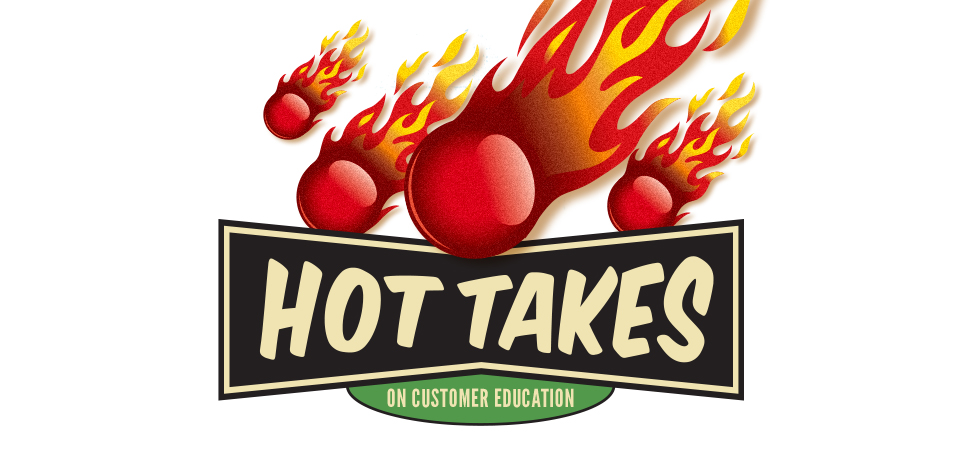I recently had the privilege of sitting down with Ryan Dillon for his Hot Takes series, where guests share spicy opinions on Customer Education. I even got to name my own hot sauce – Great Balls of Fire 🔥. This is, of course, a nod to how much customer education teams regularly juggle all the hottest business priorities!
Here’s a recap of my thoughts and insights on the topics we discussed surrounding cross-functional collaboration and validating ROI:
Hot Take #1: Marketing and Education are Natural Partners
- Education is often overlooked as an effective and valuable Marketing strategy
- Both Marketing and Customer Education have the same goal: introduce people to a new concept or way of doing things
- Education doesn’t strictly happen through formal, structured learning. Learning can very effectively occur through unstructured social learning events; like roundtables, workshops, and user groups.
- Education can be leveraged at each stage of the customer journey, making every interaction a learning experience.
Ryan asked me to ‘fess up’ about which team is the most resistant to investing in the value of education. While being “resistant” is a strong claim, I’ve found a tendency for Marketing teams to overlook the Customer Education team as a key strategic partner. Not only that, customer learning is an underrated channel to embrace and activate as part of the Marketing strategy.
In my mind, this is a big missed opportunity. The goals of Marketing are to create awareness and educate a market. This education should drive interest, demand, or an action across an audience who are all trying to learn a new way of doing something more effectively, more efficiently or more pleasantly. Customer Education professionals are especially talented in creating learning experiences that target and drive a desired outcome. Marketing and Customer Education go hand-in-hand. When Marketing strategy deliberately incorporates learning and education it can be a highly effective lead generation and lead conversion tactic.
For example, an important piece of driving demand for a product is convincing a target audience of their need. Then, educating that audience on how to best address that need or use-case, and the value they can expect to receive through the product in doing so. If Marketing and Customer Education teams execute a cohesive strategy to drive a business outcome, I’m certain the return on investment will be significant.
While Customer Education may not have as obvious a tie to revenue as Sales or Marketing, it has the power to influence revenue in a variety of ways. Competency drives confidence, and confidence drives performance. The more educated our buyers are, the more likely we are to see an increased pipeline and increased sales. The more educated our customers are, the likelier we are to see increased product adoption and usage, increased retention, and customer expansion.
This is why I believe we should be underpinning education across the entire customer journey. Customer Education drives target outcomes at each critical phase of the journey: creating awareness during the discovery and exploration phases, across the purchase and onboarding phases, through to adoption and growth. Every interaction we have with our customers is an opportunity to leverage learning to drive momentum of the marketing flywheel.
Hot Take #2: You Can’t Validate ROI Without the Right Data
- You need to connect learning data to other business goals to prove ROI
- Start with simple metrics that align to your business objectives
- Create cohorts of users who have engaged with learning, and those who haven’t
- If you’re scaling onboarding, look at time savings during the initial 90 days. If you’re improving learning experiences, look at CSAT scores. If you’re tied to adoption, look at usage, renewals and churn
Another thing Ryan and I discussed was how to effectively tell the value story for Customer Education, or measure ROI. I even shared one of my more contentious opinions when Ryan asked me how to validate ROI if you aren’t connecting learning data to other business goals. Spoiler alert: you can’t!
I strongly suggest Customer Education leaders ensure they have some specific metrics they’re targeting which correlate to other business metrics. Start with targeting those business objectives your program is designed to influence. For example, if your program aims to scale Onboarding’s efforts, look at how much time is saved by providing self-service on-demand learning. If your program is meant to support the Product organization’s quest for product adoption, look at learning consumption and its impact on adoption of different products and solutions. There are other metrics that learning can influence as well. Things like customer experience measured through CSAT and NPS, or support deflection. My top three business priorities at Seismic are: support Customer Success at scale, drive product adoption, and create learning experiences that drive loyalty and retention.
Customer Education has the ability to influence a variety of business metrics in a very positive way. Collecting and correlating the data, and demonstrating the impact of your program will be important to telling your value story.
Hot Take #3: There Are Many Routes to a Career in Customer Education
- There are many good starting points for a role in Customer Education
- Honorable mentions go to Solution Consultants, Customer Success Managers, and Product Marketers
- There’s also space for educators from traditional academia to grab a foothold! Their experience lends itself well to building or creating exceptional learning experiences
Ryan asked me for my take on which roles are good to transition to Customer Education from. I would say that there are a lot of opportunities! Here are four of my top choices from within the SaaS world.
- Solution Consultants, who are typically members of the implementation team. This role is typically client-facing. They’re comfortable working with customers, understand the product well, and explaining to customers how to implement and use the product.
- Sales Engineers, who are great storytellers and great at leading customers to value through use-case identification and building experiences.
- Customer Success Managers, who oftentimes (at early-stage companies) are responsible for training and supporting customers. They’re responsible for leading strategic discussions and driving value through use-cases and product usage.
- Product Marketing, because this team starts with the “why.” They’re well-versed in scaffolding layers of information to position a product, then creating learning context before diving into details.
Another point to mention is that academia professionals are increasingly moving into Customer Education, and I can see why! Teachers and learning and development professionals are in a good position to leverage their expertise in learning theory and apply their skill sets in curriculum design, instructional design and development, and training facilitation.
These professionals are typically strong at taking complex concepts and distilling them down into digestible, meaningful information. These are all fundamental skills required to build exceptional learning experiences for customers who are trying to learn new products and strategies.
Hot Take #4: No Single Channel is Best to Engage Learners
- Multi-channel is necessary today to engage learners in a well rounded way
- There is no “best” channel to reach customers and prospects
- Multi-channel means you can tap into different learner preferences, and meet customers where they are.
Learners have a variety of preferences in how they are engaged with and promoted to, and we need to find ways to meet them all. At Seismic, we leverage in-app promotion, we use people resources and equip them with information, we have an active community where we post news, we have a customer newsletter that we promote, and we use notifications through the Thought Industries platform.
This multi-channel approach allows us to tap into a variety of different means to engage a learner and communicate essential information and knowledge, to meet the customer where they are. Gone are the days that email alone does the trick. Ask your customers, “What is the most effective way to reach you?” and expect to need a variety of channels to effectively engage.
Melissa VanPelt is a leader in customer success and engagement, with 18+ years of experience building & contributing to high performing teams. Most recently, she built Seismic‘s Customer Education, Community, Customer Advocacy & Engagement programs from inception. These large-scale programs are now powering Seismic’s business to scale, while also driving platform proficiency across the customer base, positively influencing customer experience, product adoption, retention, & renewal at scale.



